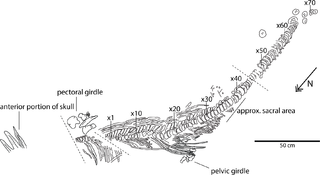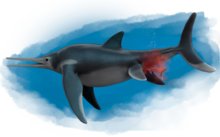
Ophthalmosaurus is a genus of ichthyosaur known from the Middle-Late Jurassic. Possible remains from the earliest Cretaceous, around 145 million years ago, are also known. It was a relatively medium-sized ichthyosaur, measuring 4 m (13 ft) long and weighing 940 kg (2,070 lb). Named for its extremely large eyes, it had a jaw containing many small but robust teeth. Major fossil finds of this genus have been recorded in Europe with a second species possibly being found in North America.
Platypterygius is a historically paraphyletic genus of platypterygiine ichthyosaur from the Cretaceous period. It was historically used as a wastebasket taxon, and most species within Platypterygius likely are undiagnostic at the genus or species level, or represent distinct genera, even being argued as invalid. While fossils referred to Platypterygius have been found throughout different continents, the holotype specimen was found in Germany.
Plutoniosaurus is an extinct genus of ophthalmosaurid ichthyosaur of uncertain validity from the Early Cretaceous of the vicinity of Ulyanovsk, European Russia.

Caypullisaurus is an extinct genus of platypterygiine ophthalmosaurid ichthyosaur from the Late Jurassic to the Early Cretaceous of Argentina. Its holotype was collected from the Vaca Muerta Formation of Cerro Lotena, Neuquen, dating to the early Tithonian stage of the Late Jurassic, about 150 million years ago. Caypullisaurus was first named by Marta Fernández in 1997 and the type species is Caypullisaurus bonapartei. It was a large ichthyosaur, measuring about 7 m (23 ft) long.

Ophthalmosauridae is an extinct family of thunnosaur ichthyosaurs from the Middle Jurassic to the early Late Cretaceous worldwide. Almost all ichthyosaurs from the Middle Jurassic onwards belong to the family, until the extinction of ichthyosaurs in the early Late Cretaceous. Ophthalmosaurids appeared worldwide during early Bajocian, subsequent to the disappearance of most other ichthyosaur lineages after the end of the Toarcian. Currently, the oldest known ophthalmosaurids is Mollesaurus from the early Bajocian of Argentina, as well as indeterminate remains of the same age from Luxembourg and Canada. Named by George H. Baur, in 1887, the family contains the basal taxa like Ophthalmosaurus. Appleby (1956) named the taxon Ophthalmosauria which was followed by some authors, but these two names are often treated as synonyms; Ophthalmosauridae has the priority over Ophthalmosauria. However, some researchers argue that Ophthalmosauridae should be restricted to the group typically referred to as Ophthalmosaurinae, with classic Platypterygiinae instead being referred to as Undorosauridae or Brachypterygiidae and Ophthalmosauria being used to unite these two groups.

Brachypterygius is an extinct genus of platypterygiine ophthalmosaurid ichthyosaur known from the Late Jurassic of England. The type species was originally described and named as Ichthyosaurus extremus by Boulenger in 1904. Brachypterygius was named by Huene in 1922 for the width and shortness of the forepaddle, and the type species is therefore Brachypterygius extremus. The holotype of B. extremus was originally thought to be from the Lias Group of Bath, United Kingdom, but other specimens suggest it more likely came from the Kimmeridgian Kimmeridge Clay of Kimmeridge Bay, Dorset, UK.

Undorosaurus is an extinct genus of ophthalmosaurid ichthyosaur known from western Russia, Svalbard, and Poland. It was a large ichthyosaur, with the type species measuring 4–6 metres (13–20 ft) long.
Mollesaurus is an extinct genus of large ophthalmosaurine ophthalmosaurid ichthyosaur known from northwestern Patagonia of Argentina.

Nannopterygius is an extinct genus of ophthalmosaurid ichthyosaur that lived during the Middle Jurassic to the Early Cretaceous. Fossils are known from England, Kazakhstan, Russia, and Norway and six species are currently assigned to the genus.

Grendelius is a genus of platypterygiine ophthalmosaurid ichthyosaur from the Late Jurassic (Kimmeridgian-Tithonian) of the UK and European Russia. It was a medium-sized ichthyosaur measuring about 4 metres (13 ft) long.
Simbirskiasaurus is an extinct genus of ichthyosaur from the Early Cretaceous of Ulyanovsk Oblast, Russia. Its type specimen is YKM 65119, a fragmentary skull and vertebral column.

Arthropterygius is a widespread genus of ophthalmosaurid ichthyosaur which existed in Canada, Norway, Russia, and Argentina from the late Jurassic period and possibly to the earliest Cretaceous.

Athabascasaurus is an extinct genus of platypterygiine ophthalmosaurid ichthyosaur known from Alberta, Canada.

Acamptonectes is a genus of ophthalmosaurid ichthyosaurs, a type of dolphin-like marine reptiles, that lived during the Early Cretaceous around 130 million years ago. The first specimen, a partial adult skeleton, was discovered in Speeton, England, in 1958, but was not formally described until 2012 by Valentin Fischer and colleagues. They also recognised a partial subadult skeleton belonging to the genus from Cremlingen, Germany, and specimens from other localities in England. The genus contains the single species Acamptonectes densus; the generic name means "rigid swimmer" and the specific name means "compact" or "tightly packed".
Palvennia is an extinct genus of ophthalmosaurid ichthyosaurian known from the uppermost Jurassic of Central Spitsbergen, Norway. It was named for PalVenn, the Friends of the Palaeontological Museum in Oslo, whose expedition led to the discovery of the type specimen. Palvennia was a medium-sized ichthyosaur, measuring 3–4 m (9.8–13.1 ft) long. It is known from a single skull from the Slottsmøya Member of the Agardhfjellet Formation that measures 86 cm long. It is unusual in having a very short rostrum, similar to Ichthyosaurus breviceps. Because of this, the orbit seems very large, but this may be effected by crushing. The single and only known species is Palvennia hoybergeti Druckenmiller et al., 2012. In 2019, Palvennia was synonymized with Arthropterygius, though maintained as a separate species, by Nikolay Zverkov and Natalya Prilepskaya, although this synonymy was objected to later that same year by Lene Delsett and colleagues, who maintained that they were sufficiently different to warrant separate genera.

Sisteronia is an extinct genus of platypterygiine ophthalmosaurid ichthyosaur known from the 'middle' Cretaceous of southeastern England and southeastern France. It contains a single species, Sisteronia seeleyi.
Muiscasaurus is an extinct genus of ophthalmosaurid Ichthyosaur that lived in modern Colombia during the Early Cretaceous. The only known species is the type Muiscasaurus catheti.

Keilhauia is a genus of ophthalmosaurid ichthyosaur, a type of dolphin-like, large-eyed marine reptile, from the Early Cretaceous shallow marine Slottsmøya Member of the Agardhfjellet Formation in Svalbard, Norway. The genus contains a single species, K. nui, known from a single specimen discovered in 2010 and described by Delsett et al. in 2017. In life, Keilhauia probably measured approximately 4 metres (13 ft) in length; it can be distinguished by other ophthalmosaurids by the wide top end of its ilium and the relatively short ischiopubis compared to the femur. Although it was placed in a basal position within the Ophthalmosauridae by phylogenetic analysis, this placement is probably incorrect.
Gengasaurus is an extinct genus of ophthalmosaurid ichthyosaur from the Jurassic. The type and only species, Gengasaurus nicosiai, was named in 2017, after the locality of Genga, Marche. It lived in Italy about 152 million years ago.
Acuetzpalin is an extinct genus of platypterygiine ophthalmosaurid ichthyosaur found in the Kimmeridgian La Casita Formation in Mexico. It is known from a partial skeleton, of which the skull is surprisingly well preserved. Its length is estimated to have been more than 3.1 metres (10 ft) long, considering the missing parts of the holotype. It was the first ichthyosaur described in 2020 and the first new ichthyosaur genus described since 2017.



















